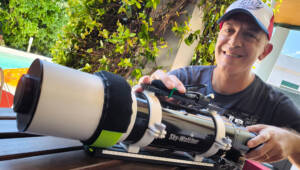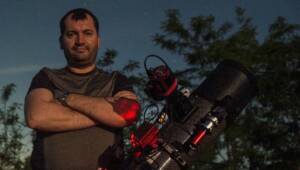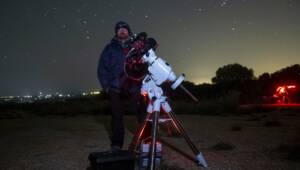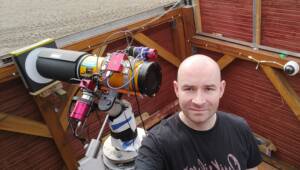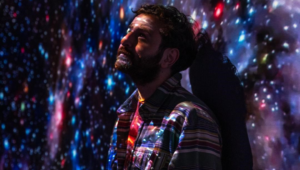Hello Logan, thanks for accepting our interview invitation. Congratulations on winning the ASIWEEK competition in week #19/2023!
Q1: At first, congratulation that your nice image won #ASIWEEK. Can you introduce yourself to us?
My name is Logan Carpenter and I am an amateur Astrophotographer living with my family in Auckland, New Zealand. By day I am a Pathologist and spend my workdays looking down a microscope. At night, when the weather allows, I spend as much time as I can under the stars imaging the amazing objects in our Universe through my telescopes.

Q2: Why do you love astronomy? What does it mean to you?
I have had an interest in astronomy since the 1980s, viewing the moon and planets through my father’s Meade 8-inch SCT and trying out a bit of very basic planetary photography with an Olympus OM1 camera. It wasn’t until Feb 2019 when I purchased my own 10-inch Meade SCT that I soon discovered a passion for astrophotography, amazed by the wonderous objects in the night sky that could be imaged from my very own backyard. In many ways it is like time travelling thousands and millions of light years into the past.

Q3: When did you start astrophotography? Is there anything you want to tell beginners?
In Feb 2019 I purchased my Meade 10inch SCT and an iOptron AZ mount, initially taking photographs with my DSLR but it didn’t take long to discover the limitations of imaging with an AZ mount. I then purchased the iOptron CEM 60 equatorial mount and my passion for astrophotography really took off from there. Later that year I purchased my first dedicated astronomy camera, the ASI294MC Pro. Learning to image through a long focal length telescope was quite the learning curve so my advice for the beginner is to start with a more widefield setup and a good equatorial mount.

Q4: What gear do you use for astrophotography? Any pictures of them?
(In this question, please include the photo of the gear you used for your winning picture.)
People often describe the journey of acquiring astrophotography gear as “going down the rabbit hole” and I am certainly well on my way down there. For the ASIWEEK photograph, I used my SkyWatcher Esprit 120 with the ASI2600MM Pro, Baader LRGB filters and Optolong 3nm Ha filter. I also have a Meade 10” SCT, an Askar 65PHQ and a WO Redcat 51. My main imaging cameras include the ASI2600MM Pro, ASI1600MM Pro and ASI294MC Pro.

Q5: Your ASIWEEK image “CG4” was outstanding! How did you capture it?
Dark nebulae are usually best captured from dark skies so I was unsure how good the data would be imaging from my Bortle 5/6 skies at home. However, I was pleasantly surprised by the results which is a testament to the quality of the cameras and telescopes available to amateur astrophotographers these days. I captured the L, R, G, B filters on moonless nights and the Ha data on moonlit nights.

Q6: What do you think is the most difficult part? How do you deal with it?
I find processing dark, dusty nebulae quite difficult compared to processing images of emission nebulae. For the CG4 image, I had to combine the Ha data with the LRGB data and used a combination of techniques in both Pixinsight (Pixelmath, etc) and Photoshop to achieve the desired result. The biggest challenge is to bring out the detail and structure of the dark dust and there are now many new tools available to us in Pixinsight to achieve this.
Q7: Do you have any unforgettable experience during these years of astrophotography? (Interesting, scary, weird or frustrating, any kinds of experiences are welcome)
In Nov 2022 and again in Jan 2022, I captured fireballs on my home security camera, both traveling a similar path through the night sky. On the first occasion I was out in my front yard imaging a target in the opposite direction and missed seeing it as it passed by behind me. The plan was for a group of us to head north to try to find any fragments of the meteorite that may have survived but unfortunately severe weather and flooding in the area put an end to that.

Q8: Do you have some shooting plans in the end of this year?
This year I plan to spend more time imaging dark nebulae and targets which are uncommonly captured.

Q9: When is your most exciting moment during a whole astrophotography project?
The most exciting time is always during the imaging session when the first exposures appear on my computer screen and I get my first inkling of the detail I’ve captured.
Q10: How do you think the future of astrophotography if take the increasingly heavy light pollution and the rapidly developed technology into consideration?
I think the future of astrophotography will be very exciting, largely due to the new technology being developed for our imaging setups. I’m hopeful that our cities and suburbs will think more about reducing light pollution and preserving our night skies. And I’m hoping that the many private companies planning to release thousands of satellites into orbit will take steps to reduce the impact on astronomy and astrophotography.

Q11: Did you have a teacher, or did you just learn everything by yourself when you started astrophotography?
I have largely learnt astrophotography myself and my biggest teacher has been, funnily enough, YouTube where other astrophotographers have shared lessons learnt and processing techniques on their channels. As a result, I am now sharing my experiences by also creating videos in the hope that it might help others.
Q12: What’s your impression of ZWO? Is there anywhere you think we can do better? Please feel free to tell us.
I think ZWO is producing quality dedicated astronomy cameras for the amateur Astrophotographer and have been pleased to see the company expanding their product range to include things like the AM5 mount and the ASIAIR and look forward to seeing what else is in production.



